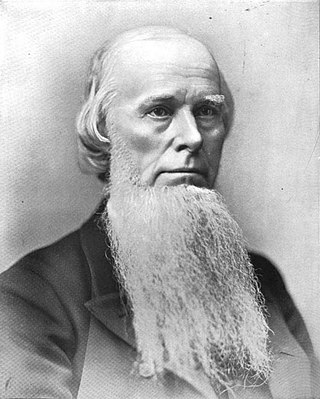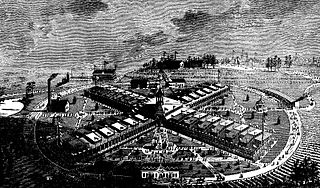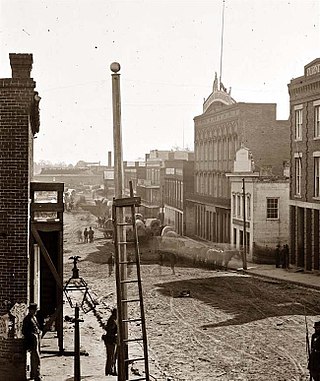
Joseph Emerson Brown, often referred to as Joe Brown, was an American attorney and politician, serving as the 42nd Governor of Georgia from 1857 to 1865, the only governor to serve four terms. He also served as a United States Senator from that state from 1880 to 1891.

SunTrust Banks, Inc. was an American bank holding company with SunTrust Bank as its largest subsidiary and assets of US$199 billion as of March 31, 2018. The bank's most direct corporate parent was established in 1891 in Atlanta, where it was headquartered.

Jonathan Norcross was elected in 1850 as the fourth Mayor of Atlanta, Georgia, serving the customary term at the time of one year. Dubbed the "Father of Atlanta" and "hard fighter of everything" by publisher Henry W. Grady, he followed three mayors elected from the Free and Rowdy Party.

John Benjamin Goodwin was born in Cobb County, Georgia, United States the son of and attended school in Powder Springs. He moved to Atlanta in 1870 and studied law at Gartrell & Stephens and a year later was admitted to the bar. From 1872 to 1874, he was a reporter for Alexander St. Clair-Abrams at the Daily Herald after which he returned to law.

William Arnold Hemphill was an American businessman and politician who served as Mayor of Atlanta from 1891 to 1893.
Thomas F. Lowe was a Georgia musician, businessman, and politician who served as the acting mayor of Atlanta, during the early part of the American Civil War.
Clarence Cooper is a senior United States district judge of the United States District Court for the Northern District of Georgia.

International Cotton Exposition (I.C.E.) was a world's fair held in Atlanta, Georgia, from October 4 to December 31 of 1881. The location was along the Western & Atlantic Railroad tracks near the present-day King Plow Arts Center development in the West Midtown area. It planned to show the progress made since the city's destruction during the Battle of Atlanta and new developments in cotton production. It demonstrated the rebirth of Atlanta and the South by announcing an end to the Reconstruction Era and the sectional hostilities that had plagued the nation for several decades.

Hannibal Ingalls Kimball was an American entrepreneur and important businessman in post-Civil War Atlanta, Georgia.
The Hebrew Benevolent Congregation Temple bombing occurred on October 12, 1958 in Atlanta, Georgia. The Hebrew Benevolent Congregation Temple, on Peachtree Street, housed a Reform Jewish congregation. The building was damaged extensively by the dynamite-fueled explosion, although no one was injured. Five suspects were arrested almost immediately after the bombing. One of them, George Bright, was tried twice. His first trial ended with a hung jury and his second with an acquittal. As a result of Bright's acquittal, the other suspects were not tried, and no one was ever convicted of the bombing.

The Piedmont Exposition of 1887 was the first exposition ever held in Piedmont Park in Atlanta, Georgia.

Clark Howell was a Pulitzer Prize winning American newspaper man and politician from the state of Georgia. For fifty-three years, he was editorial executive and owner of The Atlanta Constitution.

Judge John Collier was a superior court judge from Atlanta, Georgia, commonly considered one of the city's "founding fathers". Collier filed the charter which renamed the city of "Marthasville" to "Atlanta" in 1848.

Samuel Martin Inman was a prominent cotton merchant and businessman in Atlanta, Georgia, who is best known for the neighborhood in Atlanta that bears his name. Inman is also commemorated in the name of the Samuel M. Inman Middle School in the Virginia-Highland neighborhood.

DeGive's Opera House was the main venue for opera in the U.S. city of Atlanta from 1871 until 1893.
Washington Hall was a historic hotel in antebellum Atlanta, Georgia. Built in 1846, the building was one of the earliest hotels built in the city. The hotel, along with many other structures in the city, was destroyed in 1864 during the Battle of Atlanta.

Marietta Street is a historic street in Downtown Atlanta. The street leads from Atlanta towards the town of Marietta, as its name indicates. It begins as one of the five streets intersecting at Five Points, leading northwest, forming the southern border of Downtown's Fairlie-Poplar district, continuing through Downtown's Luckie Marietta district, then entering West Midtown's Marietta Street Artery neighborhood, until terminating at its junction with West Marietta St., Brady Ave., and 8th St.
Zachariah Armstead Rice was an American businessman who was prominent in the city of Atlanta, Georgia, in the decades before and after the Civil War. In addition to investments in textile mills, general merchandise stores, and real estate, Rice was a slave trader, Confederate officer, city councilman, and newspaper publisher of the Daily Intelligencer.

Grace United Methodist Church is a Methodist church in Atlanta, Georgia, United States. Originally organized as a mission in 1871, the current church building was designed by Francis Palmer Smith and was completed in 1923.
Oglethorpe Park was a municipal park in Atlanta, Georgia, United States. The park, consisting of about 50 acres (20 ha), was created in 1869 and hosted numerous fairs, most notably the International Cotton Exposition in 1881. Following this exposition, the park was sold by the city and was converted into the Exposition Cotton Mills, utilizing facilities that had been built for the event. The closure of the park indirectly contributed to the creation of two later parks in Atlanta: Grant Park and Piedmont Park.













